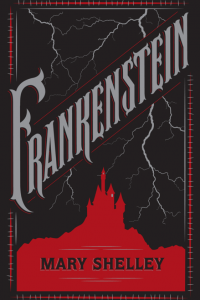“You will rejoice to hear that no disaster has accompanied the commencement of an enterprise which you have regarded with such evil forebodings.”
Who is the real monster?
Frankenstein; or, The Modern Prometheus was Mary Shelley’s first novel. First published anonymously on 1st January 1818, it was released in three volumes. It was soon republished, both in French and English, under Mary Shelley’s real name.
Since its first release, Frankenstein has received mixed reviews. It’s hailed as both an “extraordinary tale” and “disgusting absurdity”. At the time of publication, the science fiction genre didn’t exist, and today, critics consider this novel its invention.
Summary
The story follows Victor Frankenstein as he tells a sea captain about the events leading up to him becoming stranded in the Arctic. Starting with his childhood, he talks about his loving family, his desire to learn alchemy, and his eventual obsession to recreate life. As a result, the Creature is born, eight feet tall and hideous, and Victor immediately regrets his life’s work. What follows is a series of disaster after disaster, from the murder of his family, the unjust conviction of a young girl, to eventually the loss of his one true love. Victor is tormented by the Creature he created, and the Creature itself is tormented by life. But who is the real monster?
Commentary
Frankenstein; or, The Modern Prometheus is an incredible work of fiction that completely reinvented the sci-fi genre that we know today.
Praise
- Both main characters are incredibly well-written, making it impossible to decide who is the villain and who is the hero. Victor and the Creature are admirable and detestable in equal measure, which forces you to think about good versus evil in an entirely new light.
- The writing style is engaing and enjoyable to read. Mary Shelley had an exceptional way with words that allowed her to weave emotion and science together to form this novel. Because of this, the writing is addictive, leaving you completely on edge and absorbed in the story, wanting to know exactly what happens next.
- Questions of morality are asked time and time again. By the end of the novel, however, they still remain unanswered, leaving it up to the reader to decide who truly deserves compassion. This novel gives a terrifying insight into human nature. As a result, it’s a painfully human story that makes us question humanity at every page.
Critique
- Despite being a horror story, there is no ‘horror’ in the sense we know it today. There is very little terror, gore, or creepy settings. If you pick up this book looking for classic gory gothic literature, then it will disappoint.
- There are a lot of scenery descriptions. A lot. Parts of the novel are dedicated to how the lakes and trees and mountains of Switzerland look, which gets boring after a while. Victor obsesses over the natural world, and regularly describes every town he passes through in detail.
- Parts of the story are left unexplained in order for the story itself to be possible, but it gets irritating at times. The Creature learns how to speak English perfectly just after eight months, he conviently finds Victor’s family in the entirety of Geneva, and he’s able to follow Victor everywhere despite not using public transport. Although the novel itself is rooted in the unbelievable, some parts are more implausible than others.
Recommendations
Overall, I’d give Mary Shelley’s Frankenstein; or, The Modern Prometheus a four out of five. It’s a prime example of gothic literature that forces the reader to question right and wrong throughout.
I’d recommend this novel to classic fans only, as the writing style can be tough to read at times. It’s a story of humanity and morality that will stay with you long after you finish reading.

Want to read it for yourself?
Prefer to listen instead?
